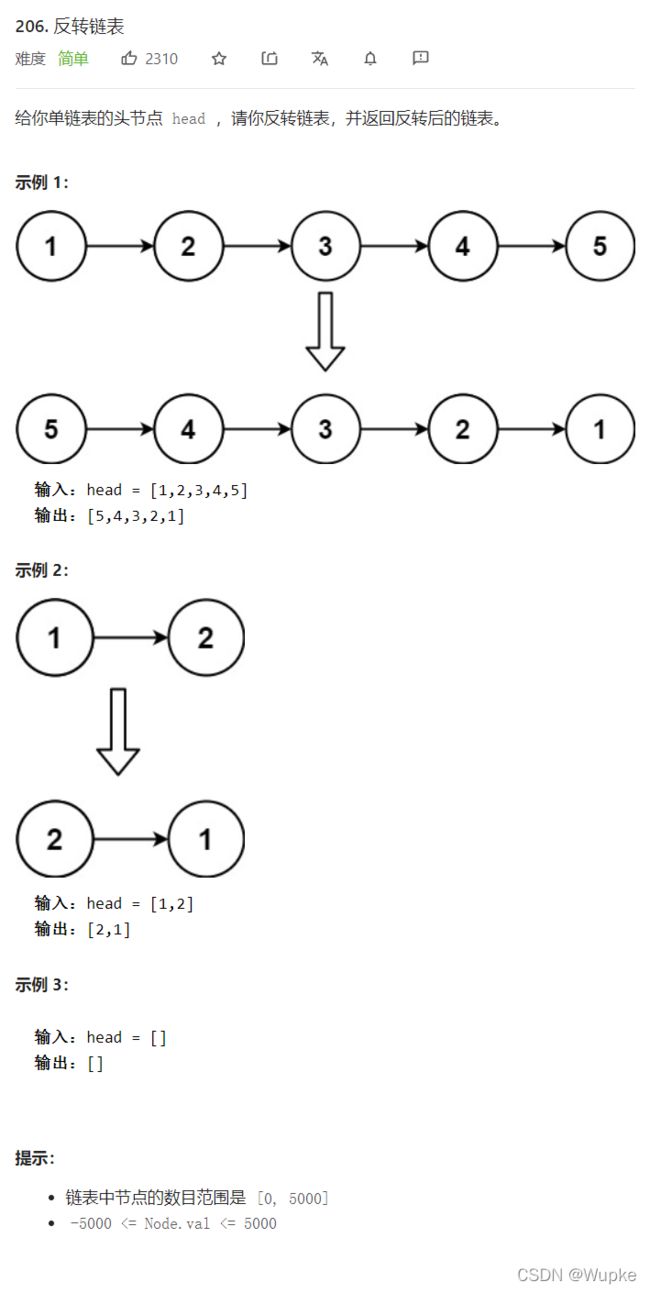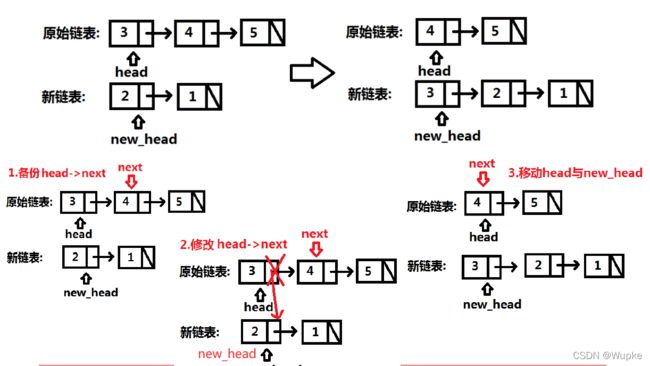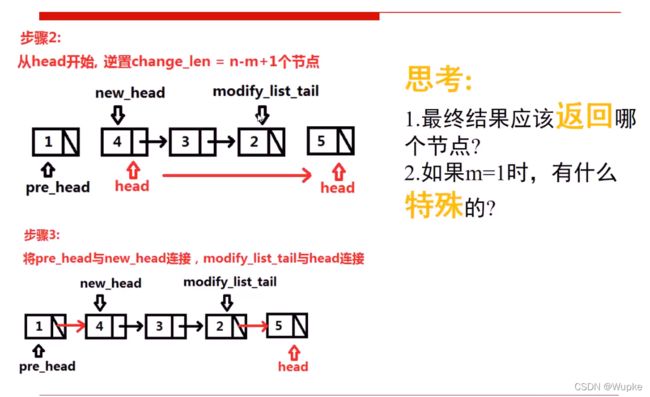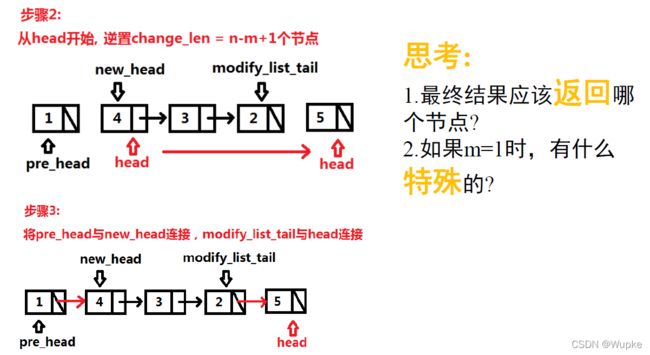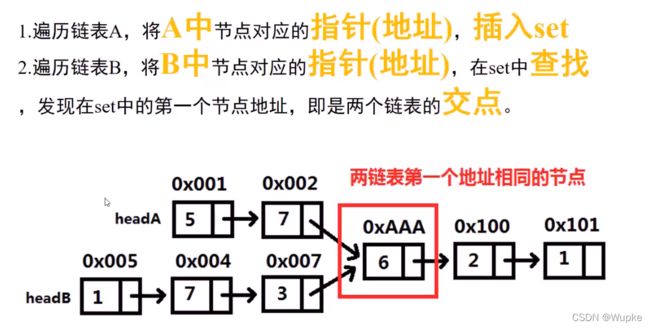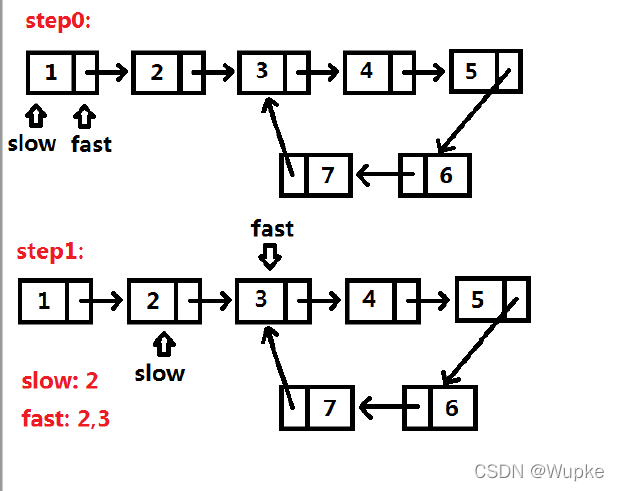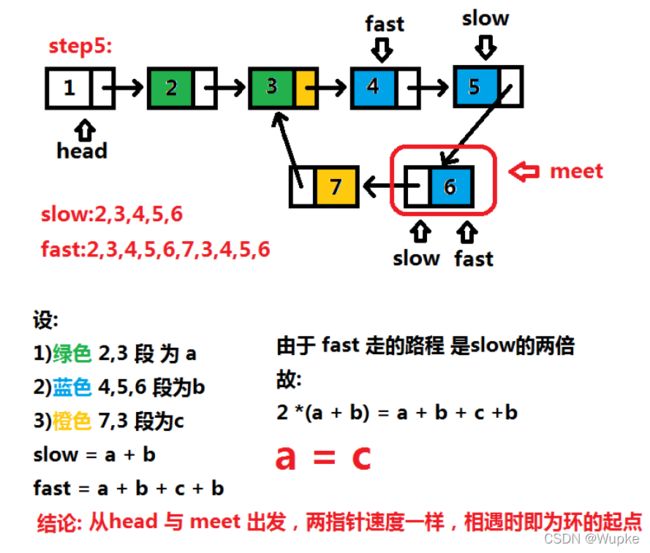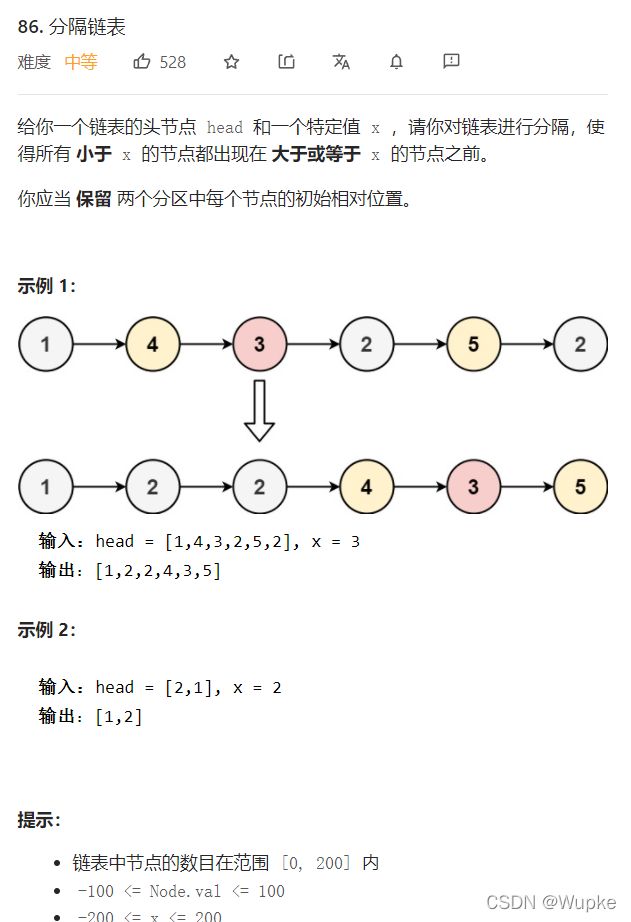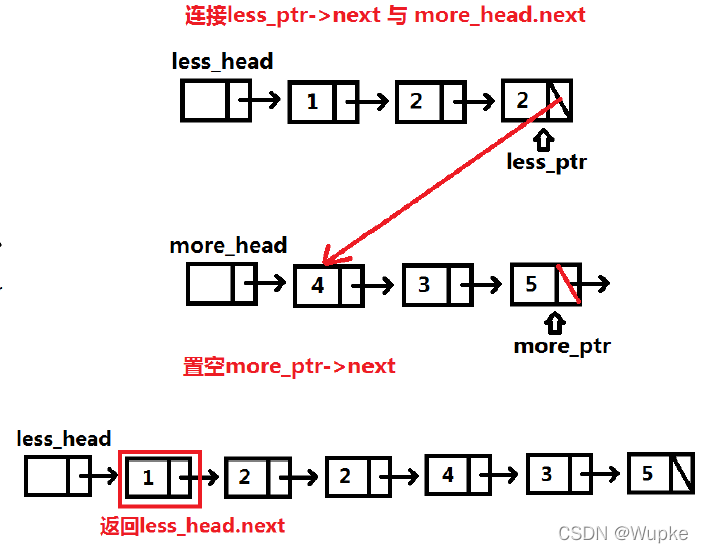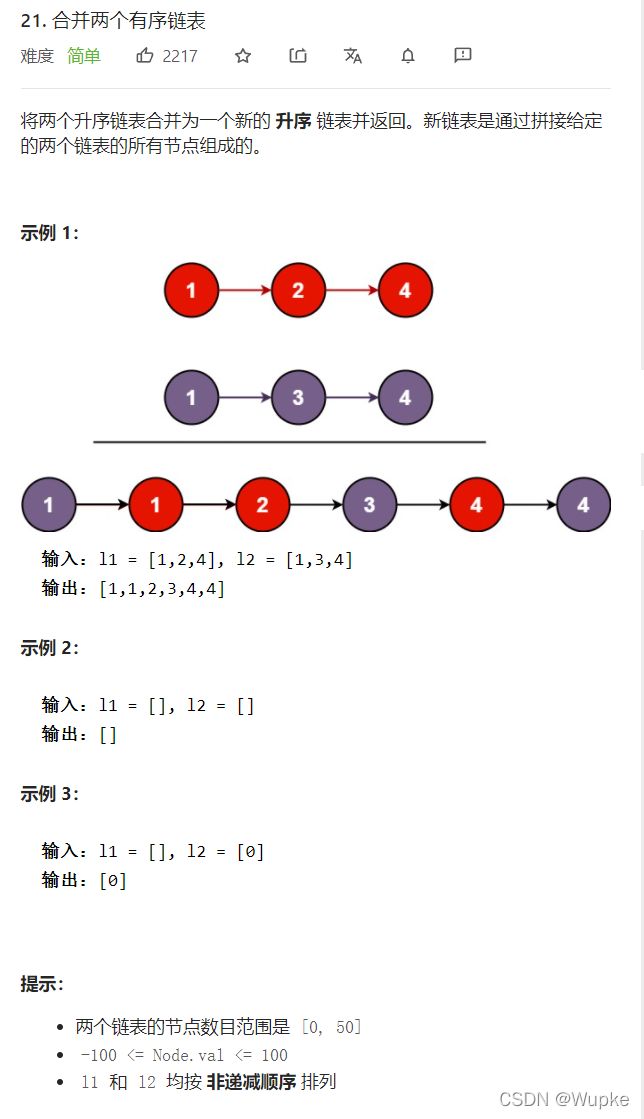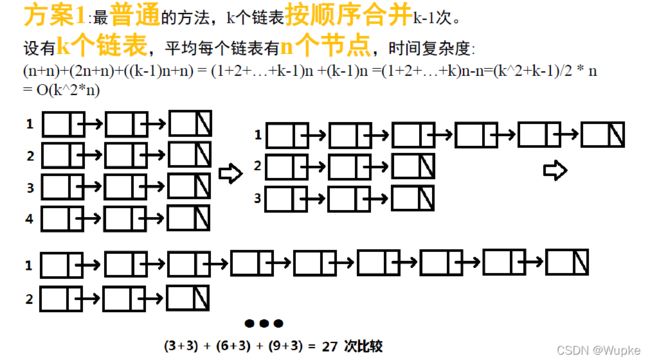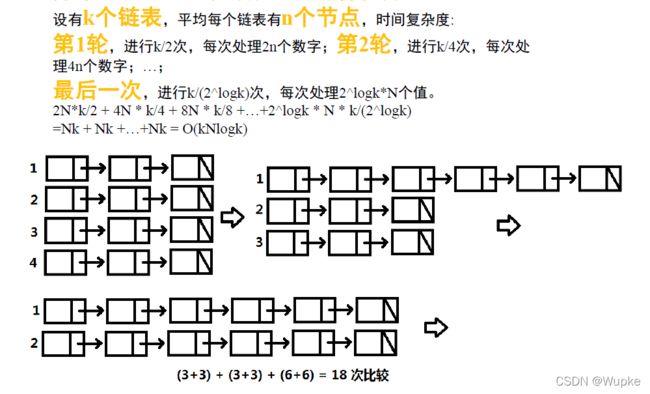【数据结构与算法-链表经典例题汇总】
【数据结构与算法-链表经典例题汇总】
-
- 典例1、链表逆序-a(easy)
- 典例1、链表逆序-b(medium)
- 典例2、求两个链表的交点-(easy)
- 典例3、链表求环 - (medium)
- 典例4、链表划分- (medium)
- 典例5、复杂链表的深度拷贝 - (hard)
- 典例6、排序链表的合并a-两个(easy)
- 典例6、排序链表的合并b-多个(hard)
典例1、链表逆序-a(easy)
-
LeetCode提交OJ测试链接:
-
OJ测试代码实现:
class Solution {
public:
ListNode* reverseList(ListNode* head) { //链表头结点指针
ListNode *new_head = NULL; // 返回链表逆序后的头结点指针
while(head){
ListNode *next = head->next; // 备份
head->next = new_head; // 更新指向
new_head = head; // 移动new_head
head = next; // 移动head ,遍历链表各个节点
}
return new_head;
}
};
- 完整的本地代码:
#include 典例1、链表逆序-b(medium)
-
同LeetCode-92-medium(中等)
-
思路:对关键的节点位置进行改变节点的连接顺序,同时注意节点的备份
1、找到特殊的节点,进行备份;
2、计算逆置要求的节点个数(可用上述的简单顺序链表的逆序逻辑);
3、对更改后的节点进行重新连接;
4、考虑特殊的情况;
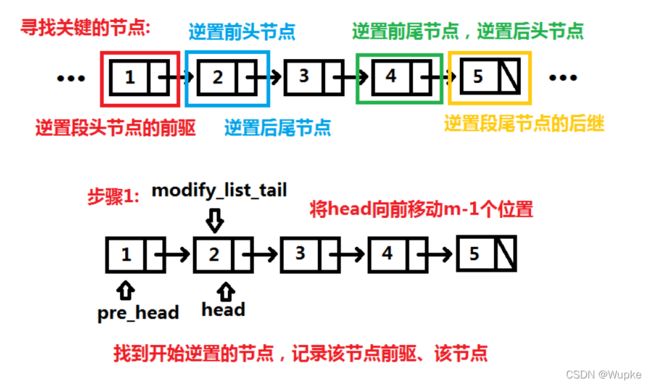
- LeetCode提交OJ测试链接.
- OJ测试提交代码:
class Solution {
public:
ListNode* reverseBetween(ListNode* head, int left, int right) {
int reverse_num=right- left +1 ; // 计算需要逆置的节点个数
ListNode* pre_head = nullptr; // 初始化开始逆置的节点的前驱
ListNode* result = head; // 最后转换后的链表头结点,非特殊情况即为head
while(head && --left ){ // 将head 向前移动m-1个位置,找到需要逆置部分的第一个节点
pre_head = head;// 记录head的前驱
head = head->next;// 向后移动一个节点位置
}
ListNode *modify_list_tail = head; // 将 modify_list_tail 指向当前的 head,就是逆置部分的链表尾部
// 开始逆置 reverse_num 个节点
ListNode* new_head = nullptr; // 声明一个临时的头结点,用于逆置
while(head && reverse_num){
ListNode* next = head->next; // 备份当前节点的指向(指针域)
head->next = new_head; // 修改节点的指向
new_head = head; // 移动 new_head 的位置
head = next; // 更新 head
reverse_num--; //
}
modify_list_tail->next = head;// 连接逆置后的链表尾 与 逆置段的后一个节点
if (pre_head){// 如果pre_head 不空,说明不是从第一个节点开始逆置的,left > 1
pre_head->next = new_head;// 将逆置链表开始的节点前驱与逆置后的头结点连接
}
else{// 如果pre_head 空,说明是从第一个节点开始逆置的,left==1
result = new_head;// 结果就是逆置后的头结点
}
return result;//
}
};
- 可本地运行的完整代码:
#include 典例2、求两个链表的交点-(easy)
class Solution {
public:
ListNode *getIntersectionNode(ListNode *headA, ListNode *headB) {
std::set<ListNode*> node_set;
while(headA){
node_set.insert(headA);
headA = headA->next;
}
while(headB){
if (node_set.find(headB) != node_set.end()){
return headB;
}
headB = headB->next;
}
return NULL;
}
};
- 本地可执行的代码:
#include - 思路2:(最优)分别计算连个链表的长度,计算较长的链表多出来的长度,移动较长的长度差与短链表指针对其,再同时移动,直到指针指向同一个节点时,返回交点。
- OJ提交代码:
- C++
class Solution {
public:
ListNode *getIntersectionNode(ListNode *headA, ListNode *headB) {
int list_A_len = get_list_length(headA);
int list_B_len = get_list_length(headB);
if (list_A_len > list_B_len){
headA = forward_long_list(list_A_len, list_B_len, headA);
}
else{
headB = forward_long_list(list_B_len, list_A_len, headB);
}
while(headA && headB){
if (headA == headB){
return headA;
}
headA = headA->next;
headB = headB->next;
}
return NULL;
}
};
- Python
# Definition for singly-linked list.
# class ListNode:
# def __init__(self, x):
# self.val = x
# self.next = None
class Solution:
def getIntersectionNode(self, headA: ListNode, headB: ListNode) -> ListNode:
######方法1:集合法
# temp= set()
# while headA:
# temp.add(headA)
# headA = headA.next
# while headB:
# if headB in temp:
# return headB
# headB = headB.next
# return None
#####方法2:移动对齐,再同步移动
len_A = self.get_list_node(headA)
len_B = self.get_list_node(headB)
if len_A>len_B:
headA = self.forward_long_node(len_A,len_B,headA)
else:
headB = self.forward_long_node(len_B,len_A,headB)
while headA and headB:
if headA == headB:
return headA
headA = headA.next
headB = headB.next
return None
def forward_long_node(self,long_len,short_len,head):
forward_step = long_len-short_len
while head and forward_step:
head = head.next
forward_step -= 1
return head
def get_list_node(self,head):
len = 0
while head:
len += 1
head = head.next
return len
- 可本地运行的完整代码:
#include 典例3、链表求环 - (medium)
class Solution {
public:
ListNode *detectCycle(ListNode *head) {
std::set<ListNode *> node_set;
while(head){
if (node_set.find(head) != node_set.end()){
return head;
}
node_set.insert(head);
head = head->next;
}
return NULL;
}
};
- 可本地运行的代码参考:
#include - 思路2: 快慢指针
- 利用结论:从 head 与 meet 出发,两指针速度一样,相遇点就是环的起点。
- LeetCode提交OJ测试链接.
- OJ测试提交代码:
class Solution {
public:
ListNode *detectCycle(ListNode *head) {
ListNode *fast = head;
ListNode *slow = head;
ListNode *meet = NULL;
while(fast){
slow = slow->next;
fast = fast->next;
if (!fast){
return NULL;
}
fast = fast->next;
if (fast == slow){
meet = fast;
break;
}
}
if (meet == NULL){
return NULL;
}
while(head && meet){
if (head == meet){
return head;
}
head = head->next;
meet = meet->next;
}
return NULL;
}
};
- 可本地运行的完整代码:
#include 典例4、链表划分- (medium)
-
思路:巧用临时头结点
遍历所有节点;
借助两个临时头节点: less_head 、 more_head
分别插入不同的两个节点的后面;
然后,更改两个暂时链表的连接方向;
置空连接后最后一个节点的控制域;
返回值:less_head->next

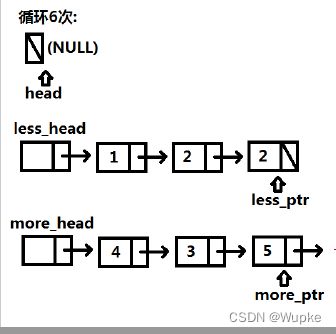
- LeetCode提交OJ测试链接.
- OJ测试提交代码:
class Solution {
public:
ListNode* partition(ListNode* head, int x) {
ListNode less_head(0);
ListNode more_head(0);
ListNode *less_ptr = &less_head;
ListNode *more_ptr = &more_head;
while(head){
if (head->val < x){
less_ptr->next = head;
less_ptr = head;
}
else {
more_ptr->next = head;
more_ptr = head;
}
head = head->next;
}
less_ptr->next = more_head.next;
more_ptr->next = NULL;
return less_head.next;
}
};
- 可本地运行的完整代码:
#include 典例5、复杂链表的深度拷贝 - (hard)
-
思路: 节点地址与节点序号对应 (STL-map)
难点:拷贝后的链表,仍有random指针特点
深度拷贝,生成的新链表节点的指针地址与之前对应顺序的节点不一样;
旧链表中,需要记录每一个节点的random节点指向的是哪一个节点;新链表中,每一个节点对应的新的节点地址;2个map
- LeetCode提交OJ测试链接.
- OJ测试提交代码:
class Solution {
public:
RandomListNode *copyRandomList(RandomListNode *head) {
std::map<RandomListNode *, int> node_map;
std::vector<RandomListNode *> node_vec;
RandomListNode *ptr = head;
int i = 0;
while (ptr){
node_vec.push_back(new RandomListNode(ptr->label));
node_map[ptr] = i;
ptr = ptr->next;
i++;
}
node_vec.push_back(0);
ptr = head;
i = 0;
while(ptr){
node_vec[i]->next = node_vec[i+1];
if (ptr->random){
int id = node_map[ptr->random];
node_vec[i]->random = node_vec[id];
}
ptr = ptr->next;
i++;
}
return node_vec[0];
}
};
- 可本地运行的完整代码:
#include 典例6、排序链表的合并a-两个(easy)
- 题目描述:
- 思路:巧用临时头节点
使用一个临时头节点,由pre指针指向,比较两个链表的头结点数值的大小,将较小的节点插入到pre指针后,并向前移动较小节点对应的指针;
遍历循环比较插入所有的节点;
更改尾部节点的控制域;
返回 pre 指针前的节点;

- LeetCode提交OJ测试链接.
- OJ测试提交代码:
class Solution {
public:
ListNode* mergeTwoLists(ListNode* l1, ListNode* l2) {
ListNode temp_head(0);
ListNode *pre = &temp_head;
while (l1 && l2){
if (l1->val < l2->val){
pre->next = l1;
l1 = l1->next;
}
else{
pre->next = l2;
l2 = l2->next;
}
pre = pre->next;
}
if (l1){
pre->next = l1;
}
if (l2){
pre->next = l2;
}
return temp_head.next;
}
};
- 可本地运行的完整代码:
#include 典例6、排序链表的合并b-多个(hard)
-
即是答案正确,时间复杂度不符合,超时,pass。
-
思路2:借助 vector 进行链表头结点排序后相连。
-
OJ提交代码:
class Solution {
public:
ListNode* mergeKLists(std::vector<ListNode*>& lists) {
std::vector<ListNode *> node_vec;
for (int i = 0; i < lists.size(); i++){
ListNode *head = lists[i];
while(head){
node_vec.push_back(head);
head = head->next;
}
}
if (node_vec.size() == 0){
return NULL;
}
std::sort(node_vec.begin(), node_vec.end(), cmp);
for (int i = 1; i < node_vec.size(); i++){
node_vec[i-1]->next = node_vec[i];
}
node_vec[node_vec.size()-1]->next = NULL;
return node_vec[0];
}
};
- 可本地运行的完整代码:
#include cpp
class Solution {
public:
ListNode* mergeTwoLists(ListNode* l1, ListNode* l2) {
ListNode temp_head(0);
ListNode *pre = &temp_head;
while (l1 && l2){
if (l1->val < l2->val){
pre->next = l1;
l1 = l1->next;
}
else{
pre->next = l2;
l2 = l2->next;
}
pre = pre->next;
}
if (l1){
pre->next = l1;
}
if (l2){
pre->next = l2;
}
return temp_head.next;
}
ListNode* mergeKLists(std::vector<ListNode*>& lists) {
if (lists.size() == 0){
return NULL;
}
if (lists.size() == 1){
return lists[0];
}
if (lists.size() == 2){
return mergeTwoLists(lists[0], lists[1]);
}
int mid = lists.size() / 2;
std::vector<ListNode*> sub1_lists;
std::vector<ListNode*> sub2_lists;
for (int i = 0; i < mid; i++){
sub1_lists.push_back(lists[i]);
}
for (int i = mid; i < lists.size(); i++){
sub2_lists.push_back(lists[i]);
}
ListNode *l1 = mergeKLists(sub1_lists);
ListNode *l2 = mergeKLists(sub2_lists);
return mergeTwoLists(l1, l2);
}
};
python3
# Definition for singly-linked list.
# class ListNode:
# def __init__(self, val=0, next=None):
# self.val = val
# self.next = next
class Solution:
def mergeTwoLists(self,l1,l2): # 合并两个链表
pre_ptr = temp_head =ListNode(0) # 创建一个临时头结点以及指向它的一个指针
while l1 and l2 : # 两个链表都不空
if l1.val < l2.val: # 比较大小依次排在临时节点后面
pre_ptr.next = l1
l1 = l1.next
else:
pre_ptr.next = l2
l2 = l2.next
pre_ptr = pre_ptr.next # 推进下一个节点
if l1: # 续借 没有 循环完的剩余链表
pre_ptr.next = l1
if l2:
pre_ptr.next = l2
return temp_head.next # 返回临时节点的下一个,就是排序好的新链表的头节点
def mergeKLists(self, lists: List[Optional[ListNode]]) -> Optional[ListNode]:
if not lists: return None
# res = None
# for list_i in lists:
# res = self.mergeTwoLists(res,list_i)
# return res
if len(lists) == 1:return lists[0]
# if len(lists) == 2: return mergeTwoLists(lists[0],lists[1])
mid = int(len(lists)//2)
list1 = []
list2 = []
for i in range (0,int(len(lists)//2)):
list1.append(lists[i])
for i in range (int(len(lists)//2),len(lists)):
list2.append(lists[i])
return self.mergeTwoLists(self.mergeKLists(list1),self.mergeKLists(list2))
- 可本地运行的完整代码:
#include - 提示:
- 在理解思路的情况下,自己动手提交;
- 尝试在纸上写代码,反复练习;
- 做LeetCode相关链表的其他题目(尝试各个层次);
- 关于题面:
听清、看清、对于别人的出题,问问能否给出具体的例子来分析;
冷静分析;
努力解决,不轻易放弃;(起码的思路,局部实现)
保持自信、谦逊的态度;
